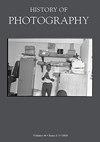帝国、早期摄影与奇观:Showman Daguerreo打字员J.W.Newland的全球职业生涯
IF 0.2
2区 艺术学
0 ART
引用次数: 0
摘要
书名很好地概括了这本书的范围。在某种程度上,它追溯了詹姆斯·威廉·纽兰(1810-57)的职业生涯,他是19世纪众多的巡回摄影师之一,也是该世纪众多的小人物之一。然而,在另一方面,这是一部令人印象深刻的银版及其相关技术的详细历史;因为纽兰不仅是一位技艺高超的摄影棚摄影师,他还是一位才华横溢、富有创造力的“分解视图秀”供应商,“分解视图展”是指从全景、立体模型和幻影中衍生出来的基于性能的视觉眼镜,并发展成现代电影。然而,同样有力的第三个层面是,从19世纪40年代到19世纪60年代,纽曼从美国南部的新奥尔良前往他最终目的地英国占领的印度加尔各答时所经过的太平洋地区,大英帝国迅速发展起来的摄影商业世界。事实上,通过将纽兰的职业生涯和他的作品定位在19世纪的流行文化网络中,《帝国、早期摄影和奇观》展示了与美术画甚至文学相比,摄影及其相关技术在传播关于帝国的思想方面发挥的强大作用。德库西和乔利创造了我们可以称之为“厚重”的媒体历史,以及纽兰工作的地方和时代。这是因为重点是广泛的社会和文化背景和影响,以及围绕纽兰库存的重要网络,而不是图像的内容。作者们声称传记是他们的研究方法。正如他们在引言中所写,“传记是唯一一个方法论框架,包括对纽兰作为多媒体艺术家、旅行者、参展商、商人和自我推销者的研究”。然而,在他们的案例中,他们所说的传记是广义的,它延伸到了对主要经济和文化跨国力量的考虑,这些力量帮助产生了从1800年持续到1914年的第一波全球化。正如作者自己所解释的那样,关注“纽兰的形象使我们能够将银版印刷术、出版印刷品和景观展览的视觉经济融入更大的移民、贸易和权力经济中”。杰弗里·巴肯(Geoffrey Batchen)将作者描述为“一种理解早期摄影史的新方式”,这种方式强调了全球奇观和交流网络,这是殖民世界的主要特征,就像纽兰工作时一样。为了将这一全球奇观和交流网络纳入视野,Jolly和deCourcy在他们的叙述中加入了他们所称的“传记的微观历史”,以描述纽兰周围的许多人物,包括他合作的人,以及影响或平行于他的银术和表演技巧的人。然而,除了这些数字之外,还有许多其他数字被提及。这篇课文读起来像一篇名副其实的本文章由计算机程序翻译,如有差异,请以英文原文为准。
Empire, Early Photography and Spectacle: The Global Career of Showman Daguerreotypist J.W. Newland
The scope of this book is well encapsulated by its title. At one level it traces the career of James William Newland (1810–57), one of the nineteenth century’s many itinerant photographers who was also one of that century’s many small-time showmen. At another, however, it is an impressively detailed history of the daguerreotype and its associated technologies; for Newland was not just a highly skilled studio photographer, he was also a talented and inventive purveyor of ‘dissolving views shows’, the term for the performance-based visual spectacles that derived from panoramas, dioramas and phantasmagorias and that evolved into modern cinema. A third level that is just as powerfully invoked, however, is that of the swiftly burgeoning commercial world of photography that was opening up across the British Empire as this existed from the 1840s to the 1860s in those parts of the Pacific world that Newman passed through on his way from New Orleans in the American South to his final destination of Calcutta in British-occupied India. Indeed, by positioning Newland’s career and his works within the popular cultural networks that were a feature of the nineteenth century, Empire, Early Photography and Spectacle demonstrates the powerful role that photography and its associated technologies played in communicating ideas about Empire compared to fine art paintings and even literature. DeCourcy and Jolly have produced what we might call a ‘thick’ history both of the media itself and of the places and times in which Newland worked. This is because the emphasis is on the broad social and cultural contexts and effects as well as the webs of significance that surrounded Newland’s inventory, and not so much on the images’ contents. The authors claim to privilege biography as their methodology. As they write in the introduction, ‘biography is the only methodological framework which encompasses a study of Newland as a multimedia artist and as a traveller, exhibitor, businessman and self promoter’. However, in their case what they call biography is broadly defined, extending as it does to a consideration of the main economic and cultural transnational forces that helped produce the first wave of globalisation that lasted from 1800 to 1914. As the authors themselves explain, focusing on the figure of ‘Newland allows us to stitch the visual economy of daguerreotypes, published prints and dissolving-views exhibitions into larger economies of migration, trade and power’. Geoffrey Batchen describes the authors as developing ‘a new way of understanding the early history of photography’, one that emphasises the global network of spectacle and exchange that was such a dominant feature of the colonial world as it existed around the time when Newland was working. In order to bring this global network of spectacle and exchange into view, Jolly and deCourcy populate their narrative with what they call the ‘the microhistories of biography’, to describe the many figures around Newland, both those he collaborated with and those who influenced or paralleled his daguerreotype practice and showmanship. However, there are many other figures mentioned besides these. The text reads like a veritable
求助全文
通过发布文献求助,成功后即可免费获取论文全文。
去求助
来源期刊
CiteScore
0.30
自引率
50.00%
发文量
23
期刊介绍:
History of Photography is an international quarterly devoted to the history, practice and theory of photography. It intends to address all aspects of the medium, treating the processes, circulation, functions, and reception of photography in all its aspects, including documentary, popular and polemical work as well as fine art photography. The goal of the journal is to be inclusive and interdisciplinary in nature, welcoming all scholarly approaches, whether archival, historical, art historical, anthropological, sociological or theoretical. It is intended also to embrace world photography, ranging from Europe and the Americas to the Far East.

 求助内容:
求助内容: 应助结果提醒方式:
应助结果提醒方式:


